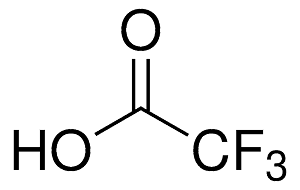Trifluoroacetic Acid

Product Description
Trifluoroacetic Acid (TFA) is a highly versatile compound with numerous industrial applications.
Product:
Trifluoroacetic Acid
CAS:
76-05-1
Synonym:
Perfluoroacetic acid; Trifluoroethanoic acid
Structure:

Typical Characteristics
Appearance
Colorless fuming liquid
Boiling point
72.4 °C
Density
1.489 g/cm3
Melting point
−15.4 °C
Molecular Weight
114.02
Odor
Strong pungent odor
Purity
99%
Refractive index
1.2850
Uses, Applications & Markets
Key applications
Markets
get a quote
We Offer Trifluoroacetic Acid
in various grades
A few of the grades available are listed below:



Trifluoroacetic Acid used in many
industry applications
Trifluoroacetic Acid (TFA) is a highly versatile compound with numerous industrial applications. Here are some of its key uses:
- Chemical Synthesis: TFA is widely employed as a reagent in organic synthesis, particularly in the pharmaceutical and agrochemical industries. It serves as a catalyst, acid, or protecting group in various reactions.
- Peptide Synthesis: TFA is commonly used as a cleavage agent in peptide synthesis, where it facilitates the removal of protecting groups from amino acids without damaging the peptide chain.
- Analysis and Purification: It is utilized as a solvent and mobile phase modifier in chromatography techniques such as HPLC (High-Performance Liquid Chromatography) and GC (Gas Chromatography) for the separation and analysis of organic compounds.
- Residue Analysis: TFA is employed in trace analysis methods, particularly in environmental and food safety testing, to extract and detect residues of pesticides, pharmaceuticals, and other contaminants.
- Protein Sequencing: It is used in protein sequencing techniques, such as Edman degradation, to cleave proteins at the N-terminal amino acid for stepwise determination of the amino acid sequence.
- Surface Modification: TFA is sometimes employed in surface modification processes, such as etching and functionalization of materials like polymers and metals, to improve adhesion or impart specific properties.
- Drug Formulation: It may be used as an excipient or pH-adjusting agent in the formulation of pharmaceuticals and drug delivery systems to enhance stability or solubility.
- Photolithography: TFA is utilized in semiconductor manufacturing processes, particularly in photolithography, as a photoresist stripper or etchant to remove photoresist materials and clean semiconductor surfaces.
- Fluorination Reagent: It serves as a source of trifluoromethyl groups in organic synthesis, enabling the introduction of fluorine atoms into organic molecules to modify their properties.
- Electroplating: TFA is used in electroplating processes as an additive to electrolytes to improve the quality and uniformity of metal coatings deposited on substrates.